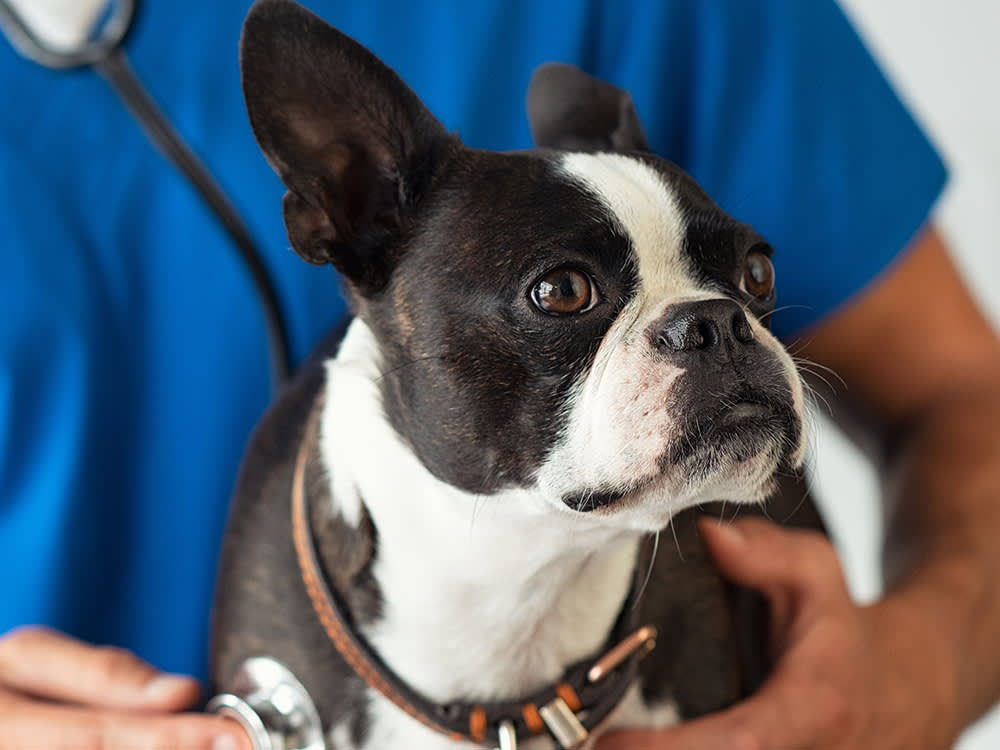9 Tips For Saving Money At the Vet
Ways to lower your bill — without compromising your pet’s health.

share article

Your pet wants you to read our newsletter. (Then give them a treat.)
Finding out that your pet is sick and needs expensive medical treatment is the worst. Of course, you want to provide your dog or cat with the best care possible — but what if you can’t afford it? These days, it can be tough with vet costs that can add up (not including emergencies and medications). The good news is there are ways you can save money at the vet while still giving your pet the care they deserve. Try these cost-saving tips.
1. Lay your financial cards on the table when talking to your vet.
Yes, this is difficult. Discussing fleasopens in a new tab is one thing; having a candid conversationopens in a new tab with your vet about your bank account is a whole other ball game. But such a dialogue can open doors to options that make better financial sense. There is rarely only one way to diagnose or treat a disease, and regardless of your financial status, you’re entitled to an explanation of the risks and benefits of every single option. Also, while pet insuranceopens in a new tab might not make sense when your pet is healthy, you’ll be thankful for it if/when your dog or cat falls ill.
2. Request a written estimate for veterinary services before they’re provided.
No one likes getting a bill that’s got a zero on the end that they didn’t expect. How else can you know if your bill will be $200 or $2,000? With an estimate in hand, you will avoid the element of surprise and won’t end up paying for things that are unnecessary. In no way does requesting an estimate reflect how much you love your pet — you’re simply being fiscally responsible.
3. Kick the once-a-year vaccine habit.
Some vaccinations, such as for parvo and distemperopens in a new tab, provide a minimum of three years’ worth of protection once the puppyopens in a new tab or kittenopens in a new tab series has been completed. If your vaccine-reminder card suggests otherwise, call your vet to double-check.
4. Don’t neglect preventive health care.
Doing so will cost you way more in the long run, trust us. Preventative careopens in a new tab — annual exams, blood work, vaccines, spaying/neutering (dogopens in a new tab / catopens in a new tab) , dental care (dogopens in a new tab / catopens in a new tab), and generally staying on top of every limp, lumpopens in a new tab, and bump — is far more affordable than treating a progressed illness. For example, administering a heartworm opens in a new tabpreventive to your dog (or outdoor catopens in a new tab) is less expensive for you (not to mention, far safer) than treating heartworm infection.
5. Feed your pet the right amount.
Many dogsopens in a new tab and cats are overweightopens in a new tab. Ask your vet if your pet is at a healthy weight. If they think your pet could lose a few pounds, try cutting back, splitting meals into smaller portions, or switch to a healthier dietopens in a new tab. Not only will this new habit translate into cost savings, it will result in a healthier pet, and a healthier pet translates into fewer veterinary bills.
6. Investigate options for paying your veterinary bills.
The clinic administrator may be willing to barter, or you could look into a line of credit that can be used to pay for veterinary expensesopens in a new tab, such as CareCreditopens in a new tab. They are as easy to apply for as a department store credit card, and they usually don’t charge service fees or interest for the first few months. This may be financially advantageous, compared to paying the bill via your usual credit card. Ask your vet hospital staff if they have an association with such a credit lender.
7. Invest in pet insurance.
Especially if you are inclined to take the “do everything possible” approach when it comes to your pet’s health. Most providers will reimburse 80 percent of your out-of-pocket expenses. If you do the math, you’ll likely find that medical insurance for your petopens in a new tab makes financial sense in the long run. Before you sign on the dotted line, make sure you are aware of the medical conditions (pre-existing diseases, inherited disorders) that will be excluded.
8. Price shop for your pet’s prescriptions.
If the medication prescribed is a human drug (such as Prozac for pet anxietyopens in a new tab), compare the human pharmacy price to what your veterinary hospital would charge. Big-box or chain pharmacies purchase medications in bulk and can pass the savings on to you. For example, Costco prices are usually among the lowest, and some human pharmacies offer substantial AAA discounts for pet prescriptions.
For veterinary prescription items your dog receives on a regular basis (such as heartworm preventive, flea and tick control products, and prescription diets), you might find the best savings via online pharmacies. Just do your due diligence and make sure it’s a reputable one — there are tons of dangerous knockoffs online (don’t buy heartworm preventatives on Amazon). And yes, you’ll still need your veterinarian’s authorization. You can ask for a written prescription and have it filled as you would your own, or you can contact an online pharmacy with your request and they will request authorization from your vet.
9. Explore all your options for affordable vet care.
Access to affordable veterinary care can be a challenge for many pet parents, particularly those living in areas without many veterinary clinics. Some veterinary clinics and local shelters maintain an emergency fund to help pet parents who find themselves in an urgent situation with their pet. Your community may also have a low-cost options for spay/neuter surgeries, vaccines, or other diagnostic needs. Your local shelter can help you find any available options.
If you can’t afford to properly care for your pet, apply for a donation from a pet health assistance organization (a comprehensive list can be found at speakingforspot.comopens in a new tab) or, as a last resort, rehome opens in a new tabyour pet with a financially secure family. Exploring your options might just save a life and will do wonders for your peace of mind.
Resources For Low-Cost Vet Treatment:
Paws4acure.orgopens in a new tab
Red Rover Reliefopens in a new tab
Paw Fundopens in a new tab

Nancy Kay, DVM
Nancy Kay, DVM is a board-certified specialist in the American College of Veterinary Internal Medicine. She was a recipient of AAHA’s Animal Welfare and Humane Ethics Award and is the author of Speaking for Spot.
Related articles
![French bulldog puppy looking scared at vet]() opens in a new tab
opens in a new tab10 Things to Ask at Your First Vet Visit
There are no stupid questions — well, when it comes to your dog’s health.
![Brown Labrador lifting front leg]() opens in a new tab
opens in a new tabHow to Get a Head Start on Your Pet’s Health
Spot lumps, limps, and lethargy early on.
![A woman with tattoos hugging her white cat in a cluttered, art-filled room]() opens in a new tab
opens in a new tabCats, Priceless. Cat Parenthood, Not So Much
A rundown of the most common cat expenses.
![cat and dog laying on bed together]() opens in a new tab
opens in a new tabWhat’s the Deal with Pet Insurance?
It covers your pet so you can get that broken leg fixed — while keeping your wallet happy.
![A woman in a yellow sweater and jeans sitting and petting the head of her gray cat eating dry food from the floor in her kitchen]() opens in a new tab
opens in a new tabHow to Find Free Pet Food Near You
These community resources can help your pet get the food they need.
![A woman in an orange cropped jacket walks her white dog toward a vet in a waiting room]() opens in a new tab
opens in a new tabI Freaked Out at the Emergency Vet So You Don’t Have To
What to expect from and how to make the most of a trip to the ER.







